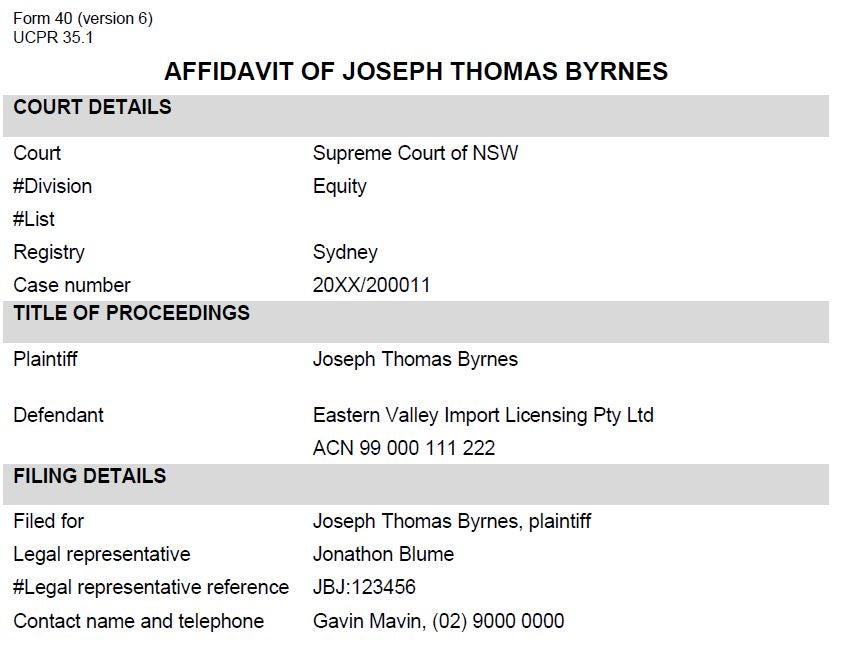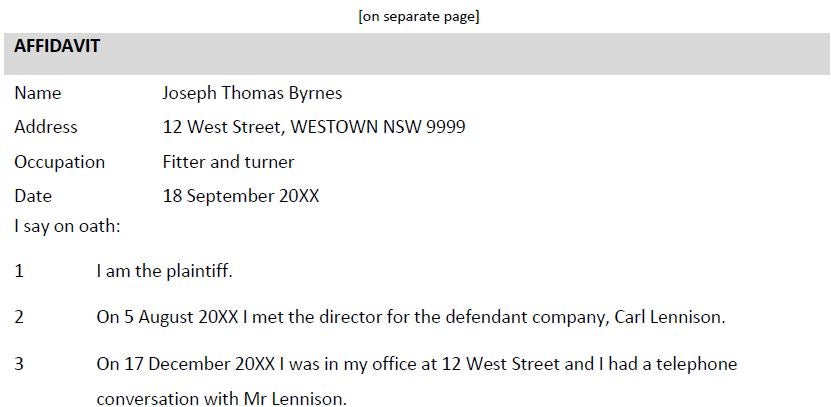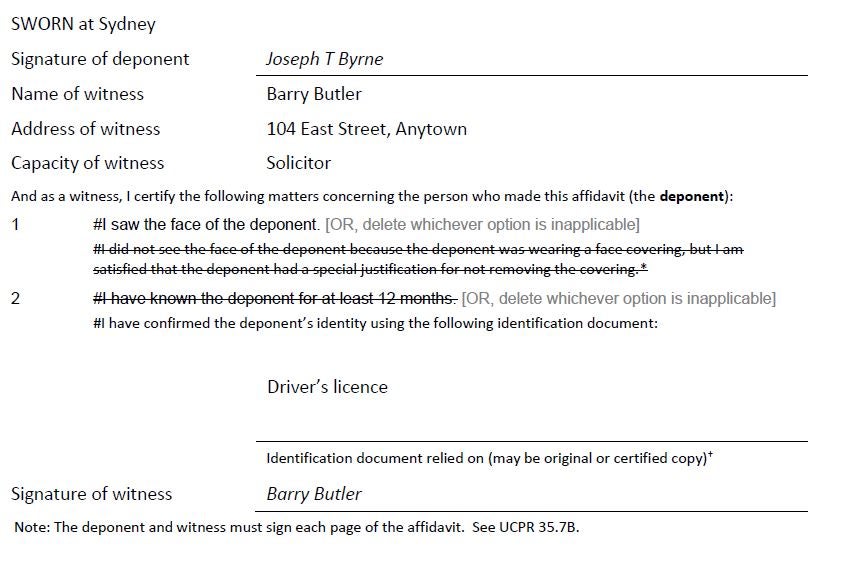An affidavit is a written statement where the contents are sworn or affirmed to be true. Affidavits must be signed in front of a witness who is an "authorised person". An authorised person includes a Justice of the Peace (JP), a solicitor or barrister. After witnessing your signature, the witness must also sign your affidavit.
For more information about where to find a Justice of the Peace, see Finding a JP on the Department of Communities & Justice website.
Affidavits are used in court as evidence. In some cases, if you make an affidavit you may not need to give evidence in person. In other cases you may still have to go to court to answer questions about the information in your affidavit.
Check the Uniform Civil Procedure Rules 2005 before using a generative artificial intelligence (AI) program such as ChatGPT to prepare documents for the Local, District or Supreme Court of NSW. These Rules permit AI use in some documents, such as submissions or reports, but you must include a statement that all citations, legal authorities and case law referred to exist and are accurate and relevant to the proceedings. The District Court and the Supreme Court also have Practice Notes which permit AI use for some types of documents, such as chronologies and indexes.
Under the Rules, you must not use AI in your affidavit or witness statement, and these documents must include a statement that AI was not used to generate the content. You must not put any confidential information about your matter into an AI program. If you are unsure or feel the Court should let you use AI due to exceptional circumstances, get legal advice.
For a helpful tool to use when writing an affidavit, see Checklist- Writing affidavits.
The person making an affidavit is called the 'deponent'. An affidavit can be made by:
- a plaintiff or applicant
- a defendant or respondent
- a witness
- an expert who has knowledge relevant to a case.
In many civil court cases in NSW, the same form is used to make affidavits. The following example shows the first page of an affidavit used in a civil case in NSW.

The details in 'Court details' and 'Title of proceedings' will be the same on all documents used in a particular case. The 'Filing details' will depend on which party the affidavit is made on behalf of. Usually this will be the plaintiff or the defendant. For example, if a witness is giving affidavit evidence for the defendant, the filing details would be:
- the defendant's name and role in the case (that is, defendant)
- the defendant's lawyer (if there is one)
- the defendant's lawyer's reference (if the defendant has a lawyer)
- the name and telephone number of the lawyer who is handling the running of the case (not always the same as the defendant's lawyer, but usually someone who works for or with the defendant's lawyer), or if the defendant has no lawyer, the defendant's telephone number.
The next page of your affidavit contains your evidence. This should be set out in a clear and logical manner, including:
- in date (chronological) order (from the oldest event t the most recent recent)
- separated by topic
- one issue per paragraph
- each paragraph numbered consecutively.

Affidavits should be written in the first person: that is, from your point of view. If your affidavit refers to a conversation, you should use the exact words spoken by the people in the conversation.
For example:
4. I said, "I need you to supply me with 2000 crates of apples" He said: "Sure that should be no problem. We'll have them delivered to you by Thursday 28 December 2009". |
If you cannot remember the exact words that were used you can say:
5. He said words to the effect of: "Sure that should be no problem. We'll have them delivered to you by Thursday 28 December 2009". |
Your affidavit should only state things that you have direct knowledge of. This means what you saw and heard.
Remember when you make an affidavit:
- be specific - use dates, times, amounts, locations and names wherever possible.
- keep it brief - do not use 10 words where 5 will do.
- know who will be reading it - a judge or magistrate, lawyers and others.
It is important that your evidence is easy to read so that the court can understand what you are trying to say. The court does not know anything about your case, except what you tell it.
Affidavits should be typed (double line spaced and 12 point font) or clearly hand written. The websites for most courts and tribunals have affidavit forms that you can download. You should ensure that you are using the correct affidavit form for the court you are in.
An affidavit should not include:
- your personal opinion. You can only include your professional opinion if you are an expert in a particular field.
- hearsay evidence. That is, evidence of what someone else has told you they heard or saw. For example, 'Sarah told me she saw John take Linda's wallet.'.
- hypothetical statements. For example, "If Jane had not travelled so much for work, we would not have broken up.'.
- generalisations. For example, 'All men are afraid of commitment.'.
- offensive or derogatory statements. For example, 'John is a bastard.'.
- legal advice you have received. For example, 'I have been advised by my lawyer that I am entitled to...'.
- your interpretation of the law.
- submissions. For example, 'It is in the best interests of the children that they live with me.'.
All this information may be irrelevant, unnecessary or offensive and the court cannot consider it. The court may reject an affidavit if it contains too much irrelevant, unnecessary, or offensive information.
Do not include any information or documents that suggest or prove you have committed a criminal offence. This may be used against you if you are charged.
Check the Uniform Civil Procedure Rules 2005 before using a generative artificial intelligence (AI) program such as ChatGPT to prepare documents for the Local, District or Supreme Court of NSW. These Rules permit AI use in some documents, such as submissions or reports, but you must include a statement that all citations, legal authorities and case law referred to exist and are accurate and relevant to the proceedings. The District Court and the Supreme Court also have Practice Notes which permit AI use for some types of documents, such as chronologies and indexes.
Under the Rules, you must not use AI in your affidavit or witness statement, and these documents must include a statement that AI was not used to generate the content. You must not put any confidential information about your matter into an AI program. If you are unsure or feel the Court should let you use AI due to exceptional circumstances, get legal advice.
It is sometimes helpful to attach a document to the affidavit if it supports something you are trying to prove. This document is called an 'annexure'.
Each annexure that is attached must be identified. For example; Annexure 'A', Annexure 'B', Annexure 'C'.
You must include a brief description of the document in the text of your affidavit.
For example:
4. On Thursday 29 December 2009, I received an email from Mr Lennison. Annexed and marked 'A' is a copy of that email. |
Each annexure must also have a cover page with a signed statement by the authorised witness that says:
This is the document referred to as Annexure A in the affidavit of Joseph Thomas Byrne, sworn at Sydney on 18 September 2011 before me Barry Butler, Solicitor. |
| Barry Butler |
Each annexure, including cover pages, must be numbered consecutively with the affidavit.
Annexures must be filed and served with your affidavit.
If you need to attach a large number of documents to your affidavit, or a number of large documents, you can prepare an 'exhibit'.
To do this you must include:
- a brief description of the document in the text of your affidavit
- a cover page with a signed statement by the authorised witness
- an index at the beginning of your exhibit, so that the court can easily find your document.
Make sure you number each page of your exhibit consecutively.
An exhibit is served (given) with an affidavit on the other party, but is not usually filed with the court.
Make sure the documents you attach to your affidavit or include in your exhibit are clear and easy to read. If they are not, the court may not consider them.
If you are not sure what to write in an affidavit, or whether to attach any documents you should get legal advice.
You need to take your affidavit to an authorised person before you sign it. The authorised person will ask you to swear (religious oath) or affirm (non-religious oath) that the contents of your affidavit is true, and then ask you to sign each page of your affidavit.
After they have witnessed you signing the affidavit, the authorised person will also sign each page and any annexures or exhibits.
If you need to correct any errors, cross out the error and put your initials next to the change. The witness must also put their initials next to the change.
For more information, see Witnessing documents.
Swearing is also known as swearing an oath. A person who believes in a god can swear by their god that the affidavit is true. The authorised person may offer them a Bible or other relevant holy book to hold while they swear the oath.
An affirmation is a solemn declaration of truth, without any reference to a god.
For example:

You only need to file and serve the affidavit when you are ordered to do so by the court. If you are ordered to file an affidavit, you can do this online or at the registry where the court is located.
Make sure your affidavit is filed and served by the date ordered by the court. The court might not allow your affidavit to be used as evidence if it is filed or served late.
Share with
Facebook
Twitter
LinkedIn